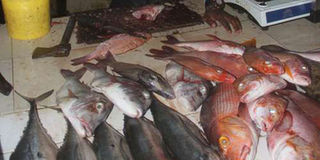Ban on night fishing in Lamu to blame for poor harvests

A trader sells fish in Lamu on December 9, 2016. Fish prices in Lamu are high due to low harvests. PHOTO | LABAN WALLOGA | NATION MEDIA GROUP
What you need to know:
- Lamu County Director of Fisheries Simon Komu told the Nation that the amount of fish available cannot satisfy the high demand.
- The ban was effected by the national government in 2011 as a security measure following a tuft of terrorist attacks and kidnappings by Al-Shabaab militants.
The fishing industry in Lamu is facing a bleak future due to the dwindling of fish caused by ban on night harvesting.
This has led to hiking of prices.
Ordinarily, a kilo of fresh fish goes for about Sh300 but since the shortage kicked in late December last year, there has been a price uptick of about Sh100.
Lamu County Director of Fisheries Simon Komu told the Nation that the amount of fish available cannot satisfy the high demand.
"The quantity of fish recorded during daytime is way too little to even cater for the subsistent needs of the fishermen and local buyers.
"In the recent days, we have been receiving fish markets from Kilifi, Mombasa and other areas but unfortunately what we have can’t even sustain us," Mr Komu said.
Mr Komu attributed the shortage to the existing ban on night fishing in Lamu East - which is the county’s hub.
The ban was effected by the national government in 2011 as a security measure following a tuft of terrorist attacks and kidnappings by Al-Shabaab militants.
Consequently, Mr Komu said the proscription has affected the growth of the sector.
Nevertheless, he said the government has initiated efforts to improve the industry.
"I blame the government for prolonging the fishing ban in Kiunga and other parts of Lamu East.
"The fish caught during day time is very little and also in smaller sizes. We have already begun improving infrastructure in the fisheries sector...we are urging the national government to lift the ban on night fishing so that the sector can expand," Mr Komu said.
Data from the county's fisheries department records that in 2014 2,266 metric tonnes of fish worth Sh 354 million was caught, but the catch experienced a downswing to 2,242 metric tonnes in 2015.
On the other hand, fish value has increased from Sh169 million in 2010 to Sh 421 million in 2015.
Most residents depend on fish to sustain their livelihoods.





